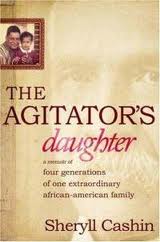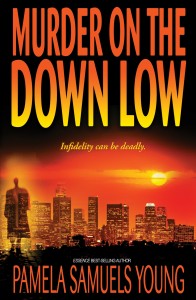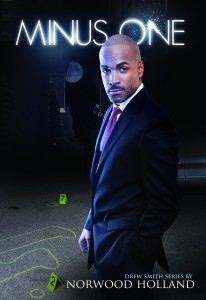The Price of Passion: A Review of The Agitator’s Daughter
July 29, 2011
 John Cashin’s death in March has renewed interest in Sheryll Cashin’s 2008 memoir The Agitator’s Daughter. It is the story of her father’s political fortune, his rise and fall and the price of passion as told by a precocious daughter coming of age in Huntsville Alabama during the height of the civil rights movement. She shares how family wealth dissipated with the moderate success of John Cashin’s political commitment. In the early 70s as a student at Fisk University I had the opportunity to hear Dr. Cashin speak. At the time uninterested in his subject, politics, I remember being struck by his energy. He had an almost larger than life presence, confident, boastful and driven. Sheryll Cashin’s story bears out this impression.
John Cashin’s death in March has renewed interest in Sheryll Cashin’s 2008 memoir The Agitator’s Daughter. It is the story of her father’s political fortune, his rise and fall and the price of passion as told by a precocious daughter coming of age in Huntsville Alabama during the height of the civil rights movement. She shares how family wealth dissipated with the moderate success of John Cashin’s political commitment. In the early 70s as a student at Fisk University I had the opportunity to hear Dr. Cashin speak. At the time uninterested in his subject, politics, I remember being struck by his energy. He had an almost larger than life presence, confident, boastful and driven. Sheryll Cashin’s story bears out this impression.
John Cashin and brother, Herschel, during their Omega partying days at Fisk made a pledge to continue the work of their great grandfather Herschel V. Cashin a radical Republican legislator in Reconstruction Alabama. The legislator’s political career like most African American office holders ended with Reconstruction and the disenfranchisement of African Americans sweeping the South. Brother Herschel studied law unable to earn a living in Alabama when the State enacted Jim Crow legislation depriving those studying out of state the right to practice leaving John Cashin alone to fulfill their fraternal pledge.
John Cashin became a dentist joining his father in a successful Huntsville Alabama practice. After military service and a tour in France he would return home to finish grand father Herschel’s work founding the National Democratic Party of Alabama in 1968. The Party became a prominent voice for Black voting rights and an important player in local politics in Black-dominated communities. It began the process of dismantling the segregationist chokehold on Alabama’s political process.
The Party in the name of Black voting rights would enjoy successes and suffer defeats until its demise in 1976 at a time when John Cashin’s reversal of fortune and personal calamities would mount. Sheryll Cashin laments the price her father paid for his commitment. A bitterness evolves to acceptance enabling the Georgetown law professor to no less carry on a family tradition of service and good works. Her memoir is an inspiring historical account delving into morality and the price of passion.
Pamela Samuels Young
March 24, 2011
Murder on the Down Low opens at the funeral of Maya Washington. Mourning are her close knit girlfriends. Maya died of AIDS infected by her down low fiancé, Eugene Nelson. Her cousin Special Moore full of vengeful grief makes a scene vowing to make Eugene pay. Among this circle of girlfriends are two attorneys and a detective each with their own work place challenges. Special with the group’s help persuades Maya’s mother to bring a wrongful death action against Eugene. Meanwhile a serial killer is targeting down low professional African American men. Special in her uncontrollable grief mounts a campaign of harassment stalking Eugene. The wrongful death suit takes a turn for the worst when Special is charged as the suspected serial killer against a mountain of circumstantial evidence. Attorney Vernetta Henderson takes the lead as the girlfriends set out to prove Special’s innocence.
Anyone who enjoys the company of sophisticated ladies will love Vernetta Henderson and her crowd. Pamela Samuels Young sketches various recognizable female personalities and their friendships while painting a faithful portrayal of the men who love them. The author has mastered the fictional technique of raising the stakes with unexpected plot twist and turns. In this moral story of tolerance and understanding a seemingly unrelated series of events keeps the reader wondering on the edge of their seat while the author mixes up a mystery package tying it all together in a neat little bow like denouement.
Young self-published her first novel Every Reasonable Doubt establishing her own imprint. She told me she self-published her first novel hoping to be picked up by a major publishing house. Three block buster Essence Best Sellers later, that is no longer of interest. Who needs the powerhouse publisher or agent? Certainly not this author, Pamela Samuels Young is proving to be a self-publishing force.
Editors, publishers, and agents, the industry shakers and movers, the gate keepers sometime get it wrong ignoring certain talent and marketability as often the case with African American fiction writers who resort to self-publishing. We saw it with Omar Tyree, E. Lynn Harris, Mary Morrison and others time and again. Young is the latest in a long line of African American writers going against established industry trends. Thanks to the Internet writers like Pamela Samuels Young rise to success no longer limited by the subjective taste of a small few.
Congressional Hearings on Islamic Terrorization
March 11, 2011
They can’t win on the issues so they run on fear. New York Republican Congressman Peter King’s attempts to demonize Islamic Americans didn’t draw the reaction he intended. The campaign pitching fear on a theme of Muslim American radicalization was met with backlash. Of the 7 witnesses only one represented law enforcement. A dramatic moment came when Rep. Keith Ellison (D-Minn.) one of only two Muslim Congressmen was overcome with emotion as he concluded his testimony referencing a Muslim paramedic Mohammad Salman Hamdani who died heroically responding to the World Trade terrorist attacks of Sept. 11, 200l. Ellison met with Hamdani’s mother before the hearing.
It seems Americans never learn. The Congressional hearing on Islamic Radicalization was an attempt at the same fear mongering and spread of misinformation seen too often in American history. Senator Joseph McCarthy stoked fears of communism with his hearings in the 1950s thus coining the phrase, McCarthyism, making accusations of disloyalty, subversion, or treason without proper regard for evidence. We saw the same fear mongering when the Japanese were rounded and placed in detention camps. And when Chinese men were deported without due process while enduring a century plus of racist framing and large scale discrimination. Blacks, Latinos, and now Islamic Americans have all come under this type of attack with prevailing stereotypes and discrimination, and misinformation.
While Republicans ignore history using the same old playbook, it would behoove Americans to remember and pay attention. Smith’s hearing might have been better served inquiring into all home grown terrorism rather than trying to demonize one ethnic group. Why are anti abortion activist bombing clinics and assassinating doctors? Why are White Supremacist organizations infiltrating the Tea Party or planting a roadside bombs along a MLK parade route? Congressman King chose to discredit non-Muslim acts of terrorism, including hate crimes.
The Washington Post Fact Checker assigned two Pinnochios to Peter King’s facts, meaning: Significant omissions and/or exaggerations and possible factual errors. A politician can create a false, misleading impression by playing with words and using legalistic language that means little to ordinary people.
Voters take heed. The Republican playbook is getting old. Unfortunately the same old plays still work: lies and disinformation without evidence.
Examining the Tea Party
October 28, 2010
The NAACP in collaboration with the Institute for Research & Education on Human Rights recently released its report exposing the Tea Party, its racism, antisemitism, xenophobia, islamophobia, nativism and its militia impulse. The various Tea Party factions (Freedom Works Tea Party, Tea Party Nation, 1776 Tea Party, ResistNet Tea Party, Tea Party Patriots, and The Tea Party Express) all make up an umbrella of spoke like organizations serving as radial limbs. At its core the central shaft comprises disaffected white leaders espousing racist ideas and advocating violence and many of whom are formally associated with white supremacist organizations. This well researched documented report is a sobering read.
The Tea Party is not a political party rather a movement that emerged through a series of locally and nationally coordinated protests in response to several Federal laws: the Emergency Economic Stabilization Act of 2008, the American Recovery and Reinvestment Act of 2009, and the health care reform bill. The movement’s primary concerns, leaders of the movement claim, are cutting back on the size of government, lowering taxes, reducing wasteful spending, and reducing the national debt and federal budget deficit.
“Take America Back” is the Tea Party mantra directed at the African American President and clearly meant to address the nation’s growing population of people of color: Latinos, Asians, and African Americans. Essence Magazine reveals what is meant in an article written by Gini Sikes, a white journalist, who was hired to go undercover and report on the 2010 convention of the Council of Conservative Citizens who kept their meetings secret from the media. “As a White journalist hired by Essence to tell this story, I’m able to mingle with them,” wrote Sikes. “I discovered they have widely varying agendas, but two things clearly unite the majority: unyielding loyalty to their race and a hatred for President Obama.”
The leaders have a hidden unspeakable agenda with goals directed toward the social realm. The movement claims not to be Republican, but embraces Republican political philosophy to which opportunistic Republicans attempted to control, advising Tea baggers to disrupt and essentially break up town-hall meetings. This attempt at capturing and channeling this new found energy, seems to have failed with the rise of little known Tea party candidates, Sharon Angle, Joe Miller, Christine O’Donnell and Rand Paul, upsetting the establishment in race after race only to later stumble because of their inexperience is delivering their extreme message and dealing with the media.
The Tea Party is like an escaped circus chimp reeking havoc and danger on to all around. The question is will the American electorate wise up and push back on this extremist movement? Voting is the only way to sedate the creature and put it back in its cage.
Diversity and Tolerance
September 18, 2010
Many believed the election of an African American President ushered in the new age of a post racial American society, one of diversity and tolerance with global impact. Well into Obama’s first term we have witnessed anything but tolerance and acceptance of cultural, racial and religious differences. Unfortunately society’s ingrained prejudices will likely take generations to eradicate. It took 400 years to make racial equality a matter of policy in the United States. A major battle tackling racism came on the education front with the 1954 Brown decision outlawing segregated schools eliminating an impediment to economic progress for many and making great strides in American society. Through desegregation school kids actually experienced diversity and tolerance in their everyday lives. Mere association alone cannot remove entrenched ideology in the war on racism and xenophobia, but the education battlefront remains the best theatre. Teaching tolerance and diversity as part of the curriculum has proven to be an effective strategy in targeting early childhood development. Teaching tolerance in elementary schools reduces the incidence of hate crimes, racism, discrimination and bigotry.
Similarly on the march of progress religious intolerance remains another battlefront. How do we educate the public to understand and respect the various religions of the world? The Establishment Clause of the First Amendment prohibits the establishment of a national religion by the Congress or the preference of one religion over another, and at the same time insuring religious freedom. It further outlaws teaching religion or what is known as “excessive entanglement” in the public schools. Public schools did much to eradicate racial discrimination but as for religious instruction there is a laissez-faire policy. When it comes to educating the public the society’s youth remains the better students. By adulthood bias and prejudice become entrenched and are less likely to be questioned.
In 1992, the American Bar Association’s Young Lawyers Division (YLD) launched four Tolerance Education pilot projects in elementary schools, middle schools, high schools, and colleges throughout the country. The ABA offered a Strategy for Teaching Diversity and Tolerance in schools recognizing children are aware of racial and gender differences at a very young age, and by age twelve they have formed stereotypes. In fact, recent studies show that tolerance education is most effective between the ages of four and nine years. Therefore, it is important to teach tolerance to young children and continue reinforcing the message over time. Age-appropriateness is involved in the creation of the different curricula that educators have developed. For instance, part of the curriculum includes classroom exercises from newsletters and newspaper sections directed toward younger audiences. Additional methods include short theatrical productions and role-playing exercises. Such programs give students a greater understanding of discrimination and prejudice.
Why not incorporate Diversity and Tolerance as part of a civics curriculum nationwide? Granted, States like Texas where political ideology controls curriculum would probably oppose it. Nevertheless its certain, diversity builds a stronger society, tolerance advances democracy, and compassion is essential for a better world.





